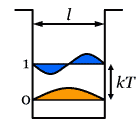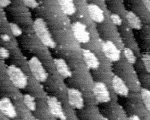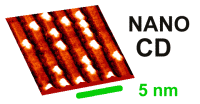Introduction to Nanoscience
Defining the nanoscale and harnessing self-assembly to create structures on that scale are two key concepts in nanoscience and nanotechnology. A few examples of nanostructures that can spontaneously form by self-assembly are: nanowires, nanodots, atomic wires, and atomic memory.
Defining the Nanoscale
How small does an object need to be in order to qualify as a nanostructure?

In other words, is there a size limit that defines the boundary of the nanoworld? The generally accepted range of sizes for nanostructures is 1–100 nm. From a Physics prospective, the definitive attributes of nanostructures are their size-dependent properties. Conversely, the emergence of size-dependent properties can be used to define the nanoscale. A few simple estimates for structures operating at room temperature places the corresponding upper limit of nanoscale between 1 and 10 nm.
Self-assembly and Self-organization
Are self-assembly and self-organization the same or different concepts?

Real-life applications require bulk quantities of nanostructures. Creating them by direct manipulation, e.g., by using various SPM tools, is for now too slow to be practical, because hours or even days may be required to "write" an individual structure. Fortunately, nanostructures can spontaneously form and arrange themselves into ordered patterns. The spontaneous formation and ordering of nanostructures are called, respectively, self-assembly and self-organization.
Nanoscale Templates

How are nanoscale templates created and used?
Various applications require assemblies of nanostructures having different properties. Specifically, the size distribution of self-assembled nanostructures and/or their relative and absolute positioning by self-organization may be critically important. The accuracy and precision of self-assembly and self-organization can be improved and controlled down to molecular or even atomic level by nanoscale templates.
Nanowires and Nanodots

Nanowires and nanodots are some of the most interesting nanostructures.
Nanowires and nanodots represent low-dimensional (1D and 0D, respectively) objects that are nearly impossible to create in the macroscopic world. The nanostructures described in this subsection are created by step-decoration. The process starts with a high-quality nanoscale template—a uniform array of atomic steps. A second material is then slowly evaporated onto such an "atomic staircase." As the deposited material accumulates along the step edges, it forms an array of nanostructures: nanowires or nanodots.
Atomic Wires and Atomic Memory

High-quality nanoscale templates result in perfect atomic structures.
Atomic wires and atomic memory realize two important theoretical limits. Atomic wires are the narrowest possible physical wires, in which electrons travel along a chain of atoms. Atomic memory reaches the limit of storage density predicted by Richard Feynman in 1959.